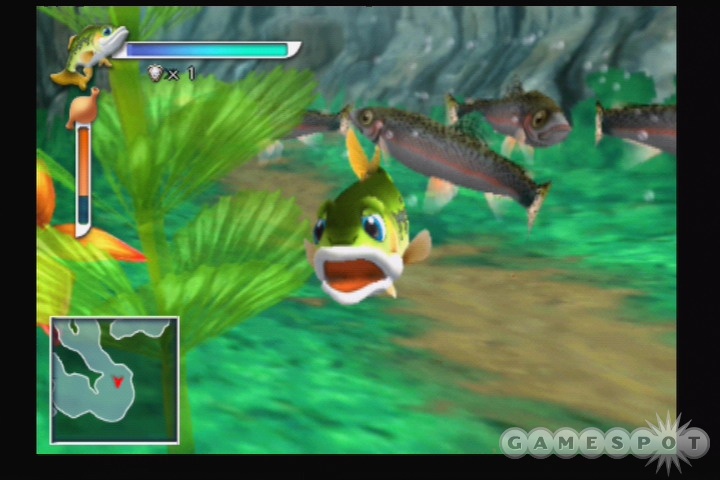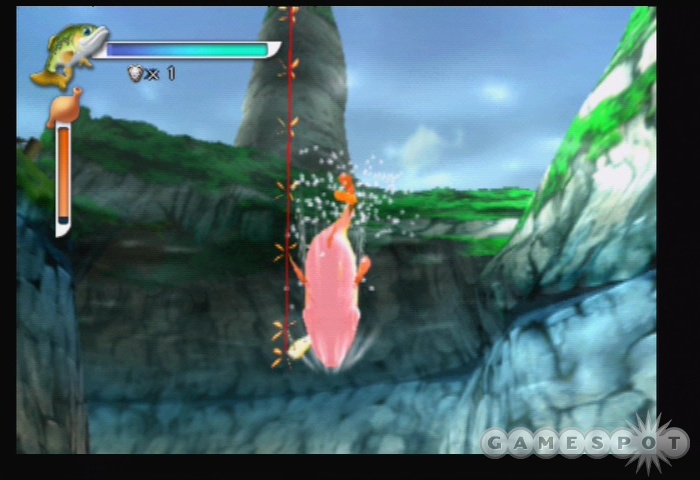As a narrative device, role reversal can be quite powerful. When the hunter becomes the hunted, it lets you empathize with how the other half lives, a half that you likely hadn't even bothered assigning emotions to in the first place. Finny the Fish & the Seven Waters, published in the US by the consistently spunky and peculiar Natsume, doesn't take the role-reversal concept quite so seriously, but it's an interesting foil to games like the Sega Bass Fishing series, without quite as much of the heavy-handed moralizing found in the Ecco the Dolphin games. Finny's tone and relative simplicity make it clear that it was designed for the younger end of the lunchbox spectrum, but vague mission structure and some unusually punishing elements work against the rest of the design.

As the eponymous Finny, you're recruited by a strange little hermit-turtle-man named Mr. Kappa to travel around the local network of ponds and tributaries, collecting special statues from the seven benevolent masters who guard over the waters. The statues are needed to ward off some rather ill-defined forces of evil, but Finny the Fish isn't so interested in epic conflict, and the overarching story doesn't come into focus until fairly late in the game. Instead, you'll spend most of your time exploring the serene waters, performing simple tasks for the masters, eating animals that are smaller than you, and avoiding being eaten by the bigger ones. Lazily trolling the waters without a specific goal isn't entertaining for long, and once you want to start making progress in the game, it's often needlessly difficult to determine what your next objective is.
Finny is a pretty unassuming little fish. He's a strong swimmer, and rapidly pumping on the X button can get him moving at a good clip--fast enough that he can break the surface. This is an important skill for Finny, as the game is rife with areas that are unreachable through a straight underwater path and that require judicious use of acrobatics. The instances where you need to catch some air are usually easy to identify, but the behind-the-back camera, which you're given no direct control over, can make it difficult to line up your jumps properly, and that's just frustrating. There are also sections where you'll have to jump your way up a stream that's going down a series of steps, and the timing on the jumps in these sequences seems unusually punishing.
Aside from the game's unwieldy camera, the presentation in Finny the Fish is pretty good and has the kind of cheery, kid-friendly Japanese vibe that Natsume games are known for. The levels aren't particularly huge, and the loading times between levels are suspiciously long, but each level teems with life. Though Finny and any character with a speaking part are rendered in a cartoony, anthropomorphic style, you'll see all kinds of fairly realistic-looking life in the water, as well as all kinds of microscopic debris. There's a nice, wavy water-refracting filter effect when you're underwater, and even the surface of the water has a nice look to it. The sounds underwater are effective and are backed up by an oddly soothing soundtrack driven by synthesized strings and electric keyboards. The most inconsistent part of the presentation is the voice acting, where the performances are just all over the place. There are a pair of duck-billed platypuses whose constant sibling rivalry is genuinely funny and convincing, but a giant orange salamander you meet early on sounds amateurish, and the frog you meet before that is just downright grating. But, for better or worse, most of the characters you meet will say their lines out loud only the first time you encounter them.
Other than performing some extremely light puzzle solving or going on a fetch quest, Finny's primary concern is food. There's a dedicated hunger meter, which will cause Finny to start rapidly losing health if it's allowed to go empty. So, as you go about your business, it's important to keep your eye out for anything alive that's smaller than you, such as insects, amphibians, shellfish, or other fish. Catching your food is pretty easy. Just hit L1 to lock onto the nearest prey, pump X to swim toward it, and then press the square button once the reticle starts flashing red. This is all you'll need to do for smaller prey, but when you start taking on more substantial creatures, they'll put up a struggle, requiring you to rapidly move both analog sticks in order to thrash them around in the water and subdue them. There are, of course, fish in the water that consider you prey, and they should generally be avoided--though you do eventually reach a point where Finny has become strong enough that he can go back and eat bigger fish that previously considered him to be prey.

Sometimes something that looks like food to Finny is actually a fisherman's lure. If you find yourself snared, you can try to swim away and hope the line breaks on its own, or you can slap the line with your tail by hitting the circle button, which, under the right circumstances, will weaken the line. Alternately, if you don't think you can break the line, you can head for the surface and thrash about in the air, which can often unhook you rather quickly. The difference between breaking the line and getting unhooked is that you get to keep the lures from the broken lines, and you'll receive various performance-enhancing bonuses as you collect more lures. Truly, the best drama in Finny the Fish is when you're trying to escape death, even though it's fairly easy to escape, and it's not necessarily game over if you do get caught.
Finny's a pretty low-key game, though when it's not low-key, it's often frustrating. It's not an exceptionally long or difficult game, but the exasperating moments make it hard to recommend this game for young players, and its otherwise mellow charm isn't quite enough to engage those with more sophisticated tastes.